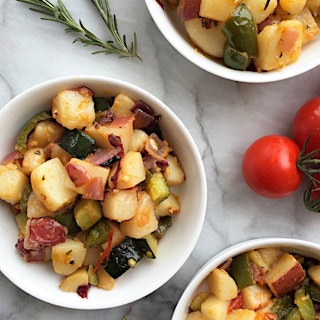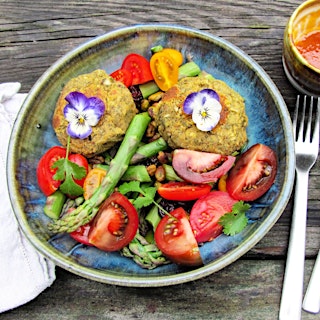Eat Less Animal Products
What’s Inside
What’s In & What’s Out
- Eat your heart out on plant-based foods. If it grows in the ground, you’re good.
- No animal products for your vegan meals—if it walks, swims, or flies, or was made by or from something that walks, swims, or flies, it’s out. This includes red meat, poultry, fish, shellfish, eggs, dairy and dairy products.
- Don’t forget about sneaky chicken or beef broths!
- Honey is an animal product, but it doesn’t pose the same health or sustainability risks as some other animal products. However, it should be eaten in moderation because of its high sugar content.
- No gelatin—found in Jell-o, commercial marshmallows, gummy candies and more. You’ll have to rethink your fave jiggly snack, and get some vegan mallows for s’more night.
- Veggie burgers and veggie bacon are fine, but make sure to check the label for quality ingredients—meat substitutes tend to be highly processed so opt to make your own, or try a less=processed, organic burger like Amy’s California Veggie Burger, Hilary’s, or Qrunch.
- Be aware of leaning on processed foods or sweets to fill the animal product void in your diet. Make sure you increase the role of produce, whole grains, and legumes in your diet instead.
- If you slip, no biggie. Slipping means you’re trying, which is what counts! You can get back on track for the rest of the day.
Why This Is A Good Idea
A diet with fewer animal products is sustainable for our environment, having less than half the carbon footprint of a meat lover’s. It reduces greenhouse gas emissions and helps protect marine ecosystems. Plus, eating less animal products prevents animal cruelty and leaves more room in your diet for plant-based foods like fruits, vegetables, whole grains and legumes that help lower your risk for heart disease and type 2 diabetes.
However, some animal products are very nutritious and have less of a carbon footprint than others. Organic meat is a great source of complete protein; fatty fish like wild-caught Alaskan salmon is rich in omega-3 fatty acids—crucial in brain function and linked to a lower rate of many diseases; organic eggs are rich in high-quality protein and provide our bodies with key vitamins and minerals; and unsweetened organic yogurt is full of calcium for your bones, and probiotics that aid in digestion.
If you do eat meat, stick to small portions of lean meats—make meat the accessory on your plate (2-5 ounces a couple times per week depending on your age and gender), and make sure it is sustainably-raised, local, and organic. Avoid red and highly processed meats such as hot dogs and sausage that have been associated with cancer and heart disease. When you eat fish, stick to small portions (3-6 ounces a couple times per week) and make sure it is wild-caught (with the exception of farm-raised frozen Barramundi), high in omega-3s, and low in mercury. (Note: Identifying ‘good fish’ isn’t always straightforward, so be sure to check Seafood Watch.) When eating eggs, choose organic, free-range / pasture-raised to ensure that the chickens are cage-free, and not given any hormones or antibiotics. As for dairy consumption, yogurt is your best option. Choose organic yogurt, and make sure it is unsweetened to avoid excess sugar.
Over 70% of strokes and colon cancer can be avoided, as can at least 80% of heart disease and 90% of type 2 diabetes, and diet is a significant factor. Along with exercise and not smoking, developing good eating habits (less animal products, less processed food and more veggies and fruit) can help cut your risk of diabetes by 95%, your risk of heart attack by 80% and risk of a stroke by half.
Basic Tips
- Check in whenever you a) consciously avoid animal products by making a checkmark on the check-in screen, or b) consume animal products by using a slip (aka free pass) on the check-in screen. If you realize you’ve made it the entire day without any animal products, check-in by making a checkmark at the end of the day.
- No, your food life is not over. In fact, you can still eat many of the dishes you love! Pasta, stir-fry and other brown rice dishes, curry, soup, salad, tacos and burritos can all be made without animal products. If you’re dining out, just remember to confirm that the dish is, or can be made without animal products. Tofu, beans, and veggies are all great ways to bulk up your favorite dish.
- Be experimental, and keep an open mind. A black bean and quinoa patty on a grilled bun with juicy tomato, crisp onion and lettuce, ketchup and mustard won’t let you down. And yes, avocado really can turn into chocolate pudding.
- Don’t underestimate flavorful oils (like olive, flax, hemp or walnut) and seasoning mix, or herbs, spices, and good ol’ salt and pepper to make your veggie dishes wow you with flavor. Try fresh herbs like parsley, cilantro, basil, tarragon, dill, rosemary and thyme. And cumin, coriander, paprika, turmeric, curry powder and fennel seed are spice drawer staples.
- Sauce it up. Sauces are a great way to jazz up just about anything, and can easily be made in your blender with ingredients like herbs and nuts. Try pesto, tahini sauce, alfredo sauce or a simple balsamic vinaigrette.
- Treat veggies as you would meat (like mushrooms and zucchini), by marinating them and cooking them on the grill or roasting them in the oven. Grilling and roasting bring out satisfying, richer, smokier flavors.
- Learn to cook one-pot dishes like stews, soups and curries. They are filling and pack a ton of flavor.
- Don’t forget about vegan proteins—whole grains, beans, nuts, soy products, hummus, lentils, and hemp seeds are all great sources.
- Add some good fats to your salad with nuts, seeds and avocado.
- Read thy label. Many things you wouldn’t expect contain animal products, like salad dressings and even candies (gummy candies often contain gelatin, a protein derived from animal material). Common animal products in disguise are gelatin, whey, and casein.
- Beware! There are a LOT of animal-product-free junk foods, like Oreos, French fries, Fritos, Swedish Fish, and unfrosted Pop Tarts. Try not to replace animal products with highly processed carbohydrates, because they will have negative health impacts too! Stick to whole foods as much as possible.
Shopping List
- Trade in the meat and fish counters for tofu, tempeh and seitan. If you are sensitive to soy and gluten, pick a vegetable such as a cauliflower steak or baked sweet potato to be the star of the meal!
- Farmers markets, farm stands, the produce department, and your garden are your new best friends. Pick up meaty/hearty vegetables like mushrooms, eggplant, cauliflower, squash, and sweet potato to help you kick the meat.
- Hit the bulk bins, the mothership of protein-rich, nutritious whole grains like amaranth, bulgur, brown rice, buckwheat and quinoa.
- Visit the ethnic foods aisle for Indian and Asian cuisine inspiration.
- Stock up on spices, and replace the old ones you have on your spice shelf. They lose flavor over time. Try a blend of cumin, coriander, paprika, turmeric, and curry powder.
- Canned beans too! Dried beans can save you money, but if you’re cramped for time, simply rinse the canned beans and go.
- Be sure to stock up on leafy greens like kale, swiss chard, spinach, and broccoli—these guys are the kings of nutrition, and they are easy to cook (a quick sauté with olive oil, garlic, salt and pepper is all you need). Plus, they’re all delicious with brown rice or multigrain pasta—a great start to a meal with less animal products.
- Get good snacks! Veggies and hummus, edamame, almond butter on an apple or toast, roasted chickpeas and nuts are all great options to keep you full and happy.
- Ditch the butter for coconut oil, and the cow milk for almond or hemp milk.
- Daiya vegan cheese is a staple for those quesadilla fans out there (yes, it melts!).
- Nutritional yeast, miso paste, tomato paste and vegetable bouillon are pantry staples—they all add richness and flavor to sauces typically derived from meat.
- Flax and chia seeds will keep the baker happy—soaked overnight, these are the perfect binder to replace egg whites.
Recipes
Creamy Cauliflower Breakfast Bowl by unconventionalbaker 
Smoked Paprika Cauliflower by HealthyHarlequin 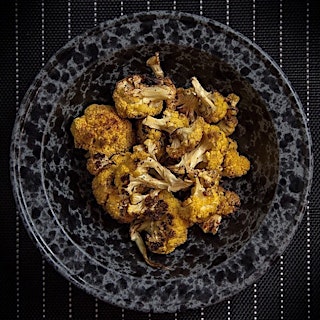
Charred Asparagus Pasta Salad by Newgent 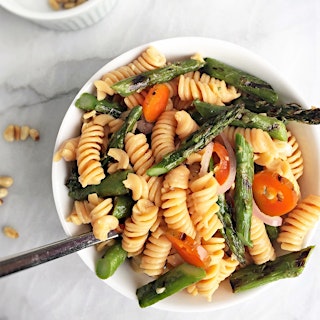
Fennel Roasted Garbanzo Beans by annefood 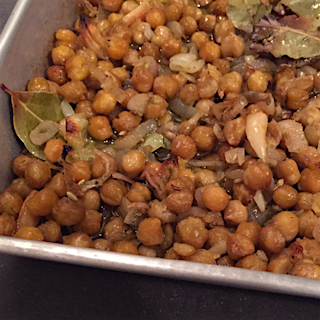
Spinach Shallot Pesto by HealthyHarlequin 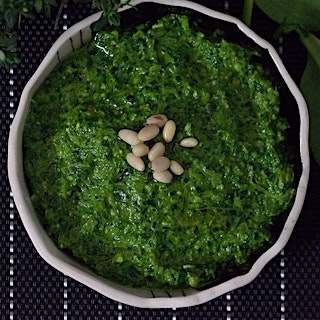
Mac and “Cheese” by simplywithout 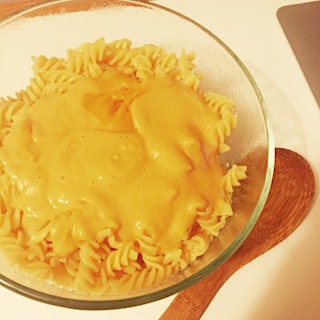
Almond Marzipan Fudge by unconventionalbaker 
Vegan Butternut Squash Lasagna by foodbymars 
Butternut Squash Lo Mein by foodbymars 
Massaman Vegan Curry by foodbymars 
Hemp & Pistachio Crusted Cauliflower by foodbymars
Mushroom Cauliflower Vegan Burgers by foodbymars
Smart Things To Read And Watch
- The Last Conversation You’ll Ever Need to Have About Eating Right
- Healthy plant-based diet linked with lower risk of type 2 diabetes
- 10 Plant-Based Proteins You Should Be Eating
- Protein of the year: Pulses
- World’s hottest destinations for vegans
- Eat Your Fruit and Veggies and Be Happy
- Why Fiber Is So Important For Your Health
- Meet the Vegan Burger That May Change the Food World
- The top 10 foods with the biggest environmental footprint
- Behind The Plate with Matthew Kenney
- The Vegan Grocery List
- Meaty Issues
- Oceana reveals mislabeling of America’s favorite fish: Salmon
- Eliminate Most of Your Chronic Disease Risk in Four Steps
Note: Diet ID is not focused on the number on the scale. Weight loss can be a byproduct of developing healthier eating habits, but if you have questions about your weight, please contact your physician.
